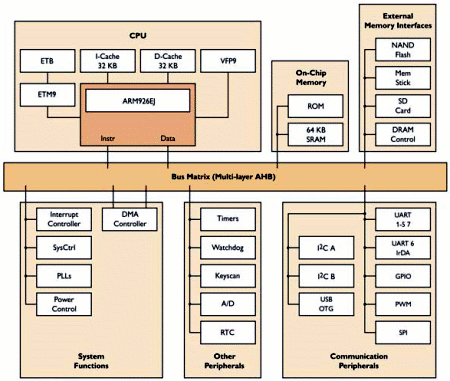First 90nm ARM9 SoC features VFPU, USB OTG
Jan 30, 2006 — by LinuxDevices Staff — from the LinuxDevices Archive — 1 viewsRoyal Philips Electronics will sample in March a highly integarted, low-power system-on-chip (SoC) processor claimed to be the first ARM9 microntroller manufactured on 90-nm process technology. The LPC3180, which runs Linux and supports an “ultra-low-power” 0.9V mode, targets POS (point-of-sales), GPS, robotics, and medical/industrial devices.
The LPC3180 is the first shipping chip in the planned Philips LPC3000-series processor family. LPC3000-series chips will all have ARM926EJ-S cores, which feature MMUs (memory management units) and Java byte-code coprocessors. Additionally, the chips will all support “major operating systems including Linux, which is the leading embedded OS,” Philips says.
The LPC3180 is based on an ARM926EJ-S core clocked at 208MHz. Along with a VFPU (vector floating point unit), the processor has 32KB each of data and instruction cache, along with 64KB of SRAM and an “internal boot ROM.”

LPC3180 architecture diagram
(Click image to enlarge)
Philips claims that the LPC3180 is the first available ARM9 chip with a VFPU, as well as the first available ARM9 MCU with USB OTG. The VFPU speeds up typical calculations by a factor of four to five in scalar mode, and more in optimized vector mode, according to the company. USB OTG allows “direct connection to PDAs, smart-card readers, and printers,” it says.
In addition to USB OTG, on-chip controllers and peripheral interfaces include seven UARTs, SPI, I2C, NAND Flash, DDR memory controllers, and a real-time clock (RTC) with a separate power domain. The “separate power domain” means that the RTC and wake-up functionalities can remain operative even when the “core power domain” is shut down.
Ata Khan, director of microcontroller innovation, stated, “By taking advantage of state-of-the-art 90-nm process technology, Philips is able to offer the most advanced ARM9 MCU with high computational power, optimized for low-power operation. With the introduction of the LPC3180, even low-cost battery-powered devices can use ARM9. Embedded systems designers have fine-grained control over power management, so that power consumption can be tailored to support specific operational requirements.”
Mikhail Spitkovsky, group leader of electrical engineering at Symyx Technologies, stated, “We use ARM-based microcontrollers for computation-intensive applications that require extensive use of floating-point algorithms. The new ARM9-based microcontroller from Philips Semiconductors with on-chip hardware floating-point and low power consumption combines high computational performance with low power consumption in a manner that is attractive for our applications.”
Availability
Samples of the LPC3180 are expected in March. The chip is expected to sell for $7.10 in 10K quantities.
An LPC3180 development board will be demonstrated running Linux at the Embedded World 2006 tradeshow, in Nuremberg, Germany, Feb. 14-16.
This article was originally published on LinuxDevices.com and has been donated to the open source community by QuinStreet Inc. Please visit LinuxToday.com for up-to-date news and articles about Linux and open source.